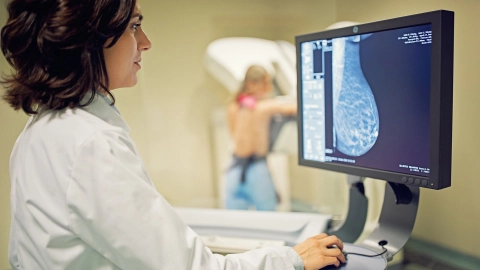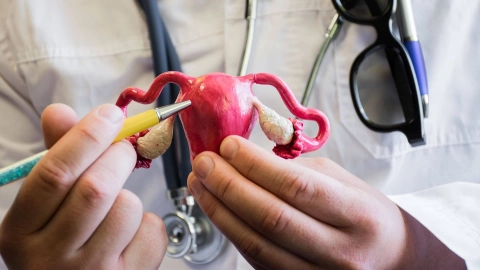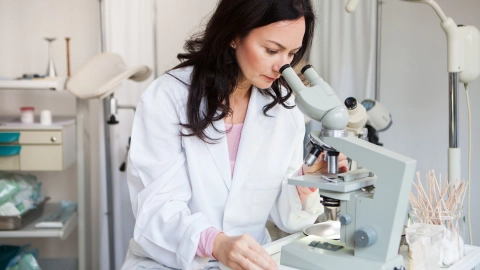Prostate cancer is the most common type of cancer in men. Around 60,000 men get prostate cancer every year in Germany.
Find out more
Chlamydia are bacteria that cause sexually transmitted diseases that frequently go unnoticed.
Find out more
A benign enlarged prostate is usually harmless, but can be distressing. Whether and what kind of treatment is an option depends on the specific symptoms.
Find out more
In Germany, breast cancer is the most common type of cancer in women, with around 70,000 women getting it every year. In many cases, breast cancer can be very effectively treated.
Find out more
Lichen sclerosus involves the appearance of white patches of skin that often become scarred, usually in the genital area. Severe itching is typical.
Find out more
Polycystic ovarian syndrome (PCOS) is a female hormone disorder in which there is an excess of male sexual hormones. PCOS can be treated successfully.
Find out more
In the past, cervical cancer was a common type of cancer in women. Pap smear screening has made it less common. The HPV vaccine can prevent cervical cancer.
Find out more
Endometriosis is a gynecological disease experienced by women. For some, it is barely noticeable; for others, it causes severe pain. Find out more about the symptoms and treatment.
Find out more
Premenstrual syndrome refers to set of symptoms that women may have before their monthly menstrual period. Typical symptoms include mood swings, headaches and abdominal pain.
Find out more
Women may experience weakening of the connective tissue in the pelvic floor for a variety of reasons. As a result, the uterus, urinary bladder, or rectum can sag.
Find out more
Ovarian cancer is often detected only at a late stage. The primary treatment is surgery, usually combined with chemotherapy. Targeted therapies are also possible.
Find out more
Genital herpes is one of the most common sexually transmitted infections (STI). It is triggered by herpes simplex viruses. The risk of becoming infected can be reduced through certain measures.
Find out more
Pubic lice are transmitted by physical proximity, particularly through sexual contact. Their bites cause bad itching in hirsute parts of the body. Here you can read what can be done about them.
Find out more
Syphilis is an infectious disease that is found worldwide. It is caused by the bacterium Treponema pallidum, which is primarily contracted through sexual intercourse.
Find out more
Gonorrhea is a sexually transmitted infection. It is common worldwide and is caused by gonococci bacteria (Neisseria gonorrhoeae).
Find out more
Varicose veins in the scrotum, also known as varicoceles, are not rare and can affect a man’s fertility.
Find out more
Ovarian cysts are tissue- or fluid-filled sacs in the ovaries. They are generally benign and go away naturally.
Find out more
Fungal infections of the vagina occur frequently in women of childbearing age. They often require only brief treatment with vaginal suppositories or creams.
Find out more
Endometrial (or womb) cancer is the most common cancer of the female reproductive organs with approximately 11,000 women being diagnosed each year in Germany.
Find out more
Menstrual cramps cause cramping and pain in the lower abdomen. Many girls and women are affected. Learn more about what causes menstrual cramps and treatment options.
Find out more
Testicular cancer is a malignant (cancerous) tumor found in men that develops in the testicles. There are two common types – the seminoma and the non-seminoma.
Find out more
If the glans (the head of the penis) becomes red and painful, this may be due to an inflammation. Inflammation of the glans is known as balanitis and is often caused by a yeast infection.
Find out more
Almost all boys are born with a tight foreskin (phimosis). This protects the head of the penis (glans) against friction, drying out and germs. It usually goes away of its own accord.
Find out more
Vulvar cancer is a tumor of the external female reproductive organs. It primarily affects older women but the prevalence among younger women is increasing.
Find out more
If a man almost always reaches orgasm too soon, this is known as premature ejaculation, the medical term for which is ejaculatio praecox. Exercises, medication or sex therapy can help.
Find out more
Being unable to have children due to a fertility problem can be very stressful and many couples seek medical assistance. Depending on the cause, there are various treatment options.
Find out more
Bacterial vaginosis often has no symptoms. It sometimes causes a grayish-white discharge with a fishy odor. If symptoms occur, they can be treated successfully.
Find out more
Uterine polyps are growths in the endometrium (uterine lining) that are mainly benign. They are often indicated by spotting and breakthrough bleeding. Surgery is not always necessary.
Find out more
Inflammation of the prostate can have a range of causes. In some cases, it is triggered by bacteria. Typical symptoms include pain and difficulties urinating.
Find out more
A hydrocele (testicular hydrocele) is an accumulation of fluid in the scrotum. In most cases, it causes no pain. It is advisable to consult a doctor in relation to the triggers and treatment.
Find out more
Some women have severe menstrual bleeding. It can be relieved with drugs and surgical interventions. But a treatment is not always necessary.
Find out more
Prostate stones are common in men from middle-age onwards, but they are usually harmless. If they cause pain or problems when urinating, they can be treated.
Find out more

































































